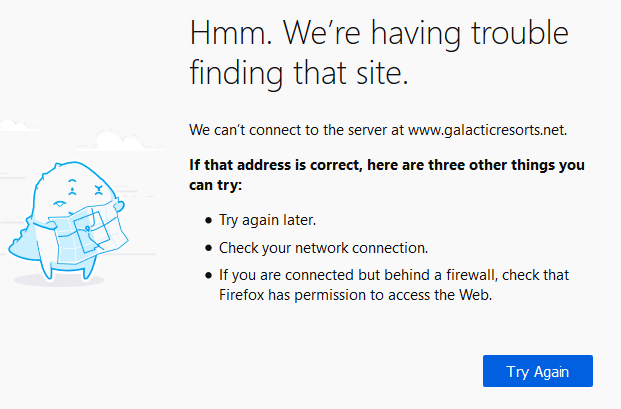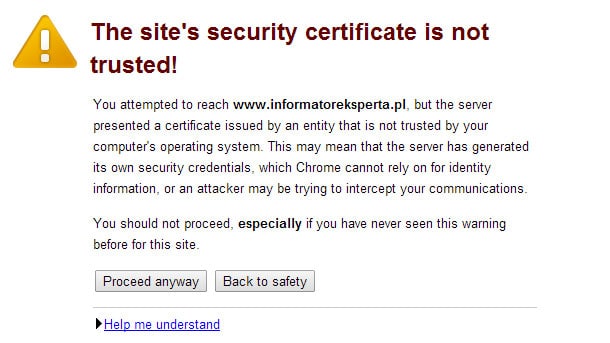As an Internet startup, you have to put out innovative, meaningful solutions for your users. Therefore, no matter what that solution may be, you’ve got to make sure that the solution is available, functioning, and has excellent performance at launch and afterwards. To help you succeed and to avoid common web monitoring mistakes, we’ve put together a list for you.
We’ve compiled a list of 11 newbie mistakes Internet startups tend to make due to budget constraints, understaffing, funding shortages, and some simply because they don’t know any better. Whether you’re a startup or any seasoned Internet service or content provider, make sure you don’t make the following newbie mistakes.
Mistake #1: Not monitoring uptime
Your site or service is going to go down. Maybe your site won’t go down today, but it will eventually come crashing down unexpectedly. You need to be prepared and make availability priority number one because if your site or service isn’t accessible, nothing else matters.

The high cost of downtime
The losses from downtime can be staggering; for example, Amazon lost an estimated $66,240 per minute back in 2013 in an outage that lasted 40 minutes. Considering the 2013 loss, imagine what a 40-minute outage would cost Amazon today.
A 40-minute outage is a big deal. However, how do those shorter outages that only last a few minutes affect a business? What if those short outages happened often? Frequent outages can add up in accumulated downtime quickly, and, as a result, you’ve blown your goal of high availability, your users’ perception of your brand suffer, and your revenue takes an immediate and long-term hit.
To avoid downtime, some Internet startups task employees to check the site or service a few times a day. However, periodic testing during the day can only capture the big outages that happen during your workday, but not the smaller frequent outages. Besides, not everyone else has the same work hours? Since your night is someone else’s day, shouldn’t you make sure users in other time zones have dependable access too?
The website uptime solution
Synthetic Availability Monitoring checks your uptime from hundreds of worldwide locations. Also, checks occur around the clock as often as once per minute, so you’ll know immediately when your baby comes crashing down. Because you always know the status of your system, you can achieve higher availability and keep your users happy.
Mistake #2: Not paying attention to mobile
Mobile has surpassed desktop use over the last year by as much as 8%. With such a high adoption rate for mobile, why do so many startups treat the mobile customer as second to the desktop user? The term “Mobile first” isn’t a marketing ploy. If your site is fast on mobile, all of your desktop users are happy too.
So, when thinking about mobile, remember, your annoyed mobile users will tolerate a slow experience for just so long (about three seconds on average). Once your site or service hits three-second load times, 40% of your visitors are already searching out the competition. Not only do they go to the completion, 27% never come back.
Optimizing your site for mobile helps you to:
- Retain users
- Increases engagement (More revenue! Who doesn’t love that?)
- Improves your SEO (Did you know Google ranks your site based on your mobile experience?)
- Avoid abusing user data plans
The tool you need for improving your site’s mobile performance and keeping it there
Our Full Page Check comes to your rescue! You can test your mobile experience and simulate almost any device and network condition you would like when you choose to use a real Chrome browser. You can also customize your screen size, user agent, and use bandwidth throttling when testing a Firefox or Internet Explorer browser.
If your mobile experience slips, Uptrends advanced alerting is quick to let you know.
Mistake #3. Not monitoring web applications
You and your team have spent many late nights up to design and code your product, and you know for a fact that it is solid. However, once you introduce the code to the wilds of the Internet, anything can happen. Your stable transactions can suddenly stop working or slow down and not always in obvious ways.
Failing transactions
So, what happens if your login or new account signup suddenly stops working? How long would it take for you to notice? A web application requires many different resources all coming from different vendors, and any of them could stop your users’ journeys cold.
For example, Amazon’s Prime Day sale has become known more for its amazing failures than for deals. Users take to Twitter pretty quickly to complain.

To mitigate functional outages, you have to have a plan in place. That plan starts with knowing there is a problem in the first place. The sooner you know about a problem, the faster you can get the rest of your plan in action to restore your application to service.
Slow transactions
How is your web application performance? We’ve all experienced the site with the fast-initial page load, but as soon as you interact with the content, you end up waiting what seems like forever for the page to respond. Those moments waiting for a response may only take microseconds, but to a user, any delay is a disruption.
A slow response is a disruption that eats away at user trust and perception. Long delays (a couple of seconds) are enough to turn the user away completely leaving you with abandoned carts, account setups, or transactions.
The solution: Web Application Monitoring
Web Application Monitoring is your key to fast fixes. Every five minutes, a checkpoint server loads a Chrome browser and steps through your critical transactions exactly like your users do. If the checkpoint gets an error or fails a validation, you will know about it.
Mistake #4: Not monitoring your DNS
Your DNS record is the roadmap to your product’s front door. The Domain Name System tells users how to get to your site by resolving domain names to IP addresses. Basically, the user puts a domain name into the browser, and the DNS says, “Sure, you’ll find domain x at this IP address.”
Now that you have a basic understanding of how DNS works, what happens when the DNS shrugs and says, “I don’t know,” or worse, sends the user to a different IP address? If a hacker manages to alter your DNS, they can easily set up a man-in-the-middle style attack or reroute users to a different site. The different site is frequently a spoof of your own where the hackers collect login credentials and other personal information from your users.
Also, did you know that a DNS problem can only affect some of your users? Because the DNS is a distributed system, the system routes users through various top-level servers before finally directing them to your site. So, if any one of the servers in the path have outdated information or becomes compromised, users from some locations can’t get through.
DNS Monitoring is super easy
By monitoring your DNS, you know if your DNS records change, become unavailable, or the problem on affects certain geographic areas. When anything seems fishy, Uptrends sounds the alarms.
Mistake #5. Not keeping track of SSL certificates
Hopefully, you have a secure site. You know, an HTTPS protocol (secure) address instead of the old HTTP (not secure) address. Having a secure site means you have an SSL certificate that you have to maintain and track.
If your site isn’t secure, you need to know a couple of things. First, if you don’t have a secure site, Google is punishing you in the rankings and giving preferential treatment to secure providers. Second, browsers may warn your users when accessing your site. Both consequences are bad for business.
Expired certificates
So, you have an SSL certificate. The certificate is a small thing that takes little thought most of the time. In fact, companies forget about them all of the time. Even Google and LinkedIn have fallen victim to an expired certificate.
An expired certificate means a user gets a warning that the certificate for a site has expired. Because the certifying entity can’t vouch that you are whom you say you are to the user, the browser issues a warning and frequently blocks the page (see example below). Users can ignore the warning, but most will take the browser’s recommendation and “get back to safety” or choose “Get me out of here!” Your loss is your competitors gain.

Missed configured and hacked certificates
Not only do staff forget about SSL certificates, but hackers looking to set up a man-in-the-middle attack also target certificates. A hacker can inject themselves into the communication between you and the user using a spoofed certificate where they capture user data. The user sees a legitimate certificate issued by the hacker, while the hacker communicates with your server with the correct certificate. So, every piece of information passes through the hacker first. The hacker has access to everything.
The SSL certificate solution
By monitoring your SSL certificate, you’ll know in advance about a certificate expiration, and you will know when a hacker changes your certificate. Also, because the hacker’s certificate will not match your monitor’s information, Uptrends catches the discrepancy right away, so you will quickly become aware of a man-in-the-middle style attack. With SSL certificate monitoring, you can head off an attack and keep your certificates current. Simple, right?
Mistake #6: Not testing beyond the company’s firewall
This mistake is a big one, and many companies mistakenly test their Internet assets from behind their firewall. Companies buy or write their own testing software that checks their site or service from their own office or data centers, or they do manual checks from their desks. Well, some testing is better than none, but with testing behind your firewall, you only know that your website or service is available and works for anyone accessing your site or service from the safety of the firewall. You have no idea if the site is accessible and functioning for the people that matter, your users.
Uptrends has Private Checkpoints that can test your APIs and web services you use internally, but for your Internet-facing assets, you want to use our extensive checkpoint network of over 200 globally located checkpoints to monitor your system. Monitoring from behind your network’s firewall will not give you information about:
- Latency
- DNS issues
- Availability
- Performance
Mistake #7: Not monitoring their APIs
When you offer an API, it is your responsibility to make sure the API remains available, responsive, and working. Period. Availability isn’t enough, you may be able to ping a server, but that doesn’t prove that the API is working. To truly test an API, you need to make an API request and examine the results, and if the interaction requires multiple requests with reuse of values from earlier requests, you need to test those as well.
Uptrends’ API Monitoring can test and verify even complicated API scenarios. You have access to variables for extracting response data. Store the value for later use, and you can make assertions on the data and the response to ensure that your API responds as expected.
Mistake #8: Not monitoring the APIs your website or service relies on
So maybe you don’t offer an API, but you probably rely on one or more for your website or service to work. By monitoring APIs you rely on, you can get out in front of issues and work towards a fix faster. At the very least you have a reason for an outage. You can alert the API provider and reassure your users that a fix is on the way.
Mistake #9: Not tracking your actual users’ experiences
Synthetic monitoring is a must for all providers, but by knowing exactly how your site or service performs for your actual users, you can optimize for all of them. Every user accessing your services and content does so using a unique combination of device, operating system, browser, and location. Real User Monitoring (RUM) can gather performance data from each of your users as they navigate your site. A tiny script grabs key metrics, aggregates them, and makes them available to you in almost real time.
By knowing from where and how users access your site, you can also customize your synthetic monitoring to better mirror your users. RUM helps you to identify:
- Preferred user environments: device, operating system and version, browser and version, and location
- Latency issues
- User concentrations
- Performance by location
- Load time as well as network, frontend, and backend durations
Mistake #10: Ignoring server availability and response times
Something as simple as a ping or connect can tell you quite a bit about the health of your servers. By monitoring and setting an upper limit for server response times, you will know when your servers are becoming overloaded or possibly headed towards a hardware failure. Besides pings and connects you can also monitor your:
- Database servers take an especially hard hit, by monitoring them, you know that the SQL Server or MySQL databases are active and available.
- IMAP, POP3, and SMTP email servers are vital to internal and user communications. A simple test can make sure your emails servers are still up and responsive. You can also authenticate users for a more in-depth test.
Mistake #11: Trusting your hosting providers to do your web monitoring
Sometimes hosting companies promise to monitor your site for you as part of their service agreement. Unless the provider is giving you access to the monitoring tool, you really have no idea what or how they are monitoring. In fact, chances are, they are only monitoring availability with no attention paid to performance or function.
With Uptrends, you can see your site’s uptime and make sure that your provider is living up to their service level agreement (SLA) with Uptrends SLA monitoring. You will also gain important performance and functionality information that your hosting company probably isn’t providing you at all.
Conclusion
If you’re an entrepreneur with an Internet startup or work for an established brand, you need to make sure that you aren’t making any of the above mistakes. Uptrends has the tools you need to make sure you’re protecting your brand on all fronts.
Flexibility to lead to your success
Uptrends has the flexibility for you to design a monitoring strategy to fit your current situation, and as your business grows. A great place to start is with synthetic monitoring to track uptime and performance, but you will want to expand into real-user monitoring to make sure you’re taking care of your base.
Help when you need it and the plan to fit your needs
We’ve got a support team, Academy, and Knowledge Base to help you along the way, so you don’t need to be a tech guru to set up your monitoring. Uptrends has plans to accommodate any budget, and you can try Uptrends free for 30 days. No commitment or credit card needed. Sign up for a Business trial so that you can try out all of the monitoring options Uptrends offers.





Leave a Reply